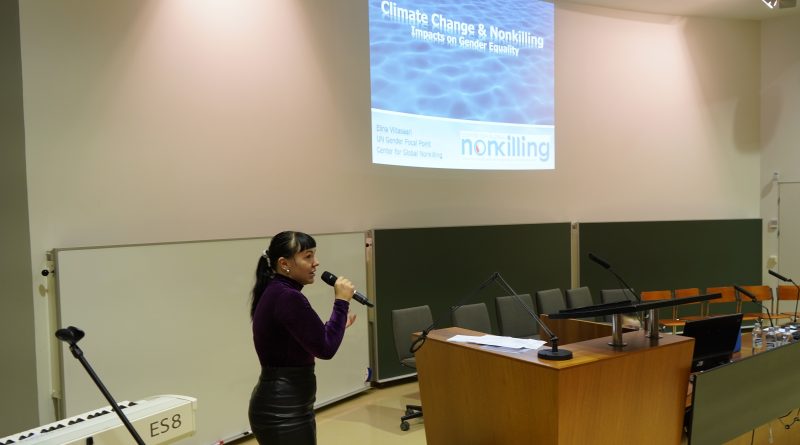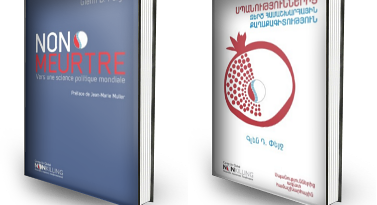Climate Change and Nonkilling: Impacts on Gender Equality
The Center for Global Nonkilling joined the first Vaasa Climate Change Conference & Networking Forum, organized by the University of Vaasa, in Finland, on September 26-28, with a lecture on “Climate Change and Nonkilling: Impacts on Gender Equality” delivered by CGNK UN Gender Focal Point Elina Viitasaari. The event was aimed at inspiring broader audiences to pursue local solutions to fight against climate change. Elina called for “Nonkilling Gender-Responsive Adaptation to Climate Change”, taking into account the specific challenges and vulnerabilities faced by women and girls.
The presentation served to advance the written statement that was submitted by CGNK to sixty-fourth session of the Commission on the Status of Women that is planned to take place at the United Nations Headquarters in New York from 9 to 20 March 2020. The 2020 CSW annual meeting will also mark the twenty-fifth anniversary of the Fourth World Conference on Women and adoption of the Beijing Declaration and Platform for Action (1995), making it a particularly important moment to address the pressing issue of climate change.
Nonkilling Gender-Responsive Adaptation to Climate Change: CSW Written Statement
There is not a thing that will not be affected by climate change. Tackling climate change needs to be done with every sustainable development goal in mind. One area that is sensitive for the changes in climate is gender equality. While the past decades have seen significant advancements and improvements, the challenges brought by climate change can not only stop this shift towards increasing equality but bring it backwards, leading to higher level of violence and killing of women and girls, if there are no adequate responses. Those responses require strong gender aspects on both prevention and enforcement.
The Center for Global Nonkilling has argued on its previous statements (E/CN.6/2015/NGO/21, E/CN.6/2016/NGO/7 and E/CN.6/2018/NGO/8) how violence against women and girls should be tackled through different Sustainable Development Goals, which are essentially interdependent. In addressing climate change, we wish to specifically point out the synergies between SDG5 on gender equality and SDG13 on climate action, and urge Member States and all relevant actors to take the progressive threat for violence against women in serious account when tackling climate change.
Climate change affects most crucially those groups that are already in vulnerable situation. Often, such groups are women and girls. Women already do most of the household-chores and use more time on doing unpaid work compared to men. This affects women’s possibilities to take part in economic and social activities and in many cases stops girls from going to school. Within the Millennium Development Goals timeframe the global school enrollment rate for girls got higher than ever before, and this rate needs to be increasing during the SDGs as well. Girls receiving education is one of the most effective ways to tackle forced prostitution, female genital mutilation, child marriages and other kind of violence.
In many societies, women are those who gather the firewood and water for their family, and the time spent on those trips will most likely be higher as women need to look for the water further and further. These trips expose women to the threat of violence, especially sexual violence, putting womens’ bodies and lives at risk. The effect of climate change on farming can already be seen through weather changes that make seasons too dry or too rainy for successful farming. In certain areas, when families do not get enough money from agriculture, selling their daughters for marriage or sending them away while exposing them for human trafficking is seen as a solution.
Climate change increases the amount of extreme weather events. In natural catastrophes the mortality rate for women is 14-times higher than for men. After such disasters violence against women has been reported to increase. Rapes, human trafficking, and child marriages have increased immediately after disasters. Furthermore, living in a stressful situation without daily routines bursts often out in domestic violence. This is why preparation for climate change regarding disaster and emergency response and relief must incorporate a gender perspective to effectively protect women and girls in vulnerable situations.
Shifting climate conditions has not only enforced on-going armed conflicts but could become a major driver for future conflicts if these are not adequately prevented. Climate change affects poverty and access to life-sustaining resources that are often key factor in the emergence of armed conflicts. Pastand on-going conflicts have shown us the heavy consequences conflicts have on women and girls as many of the wars are being fought over women’s bodies. Sexual violence is used as a tactic of war, as a way to torture, and/or for ethnic cleansing. Conflicts also exacerbate child marriages, human trafficking, female genital mutilation, and so-called honor killings. Furthermore, conflicts, particularly those involving indigenous communities, have targeted women through rape and sexual violence in levels reaching genocidal dimensions.
Different conflicts have pushed millions of people to flee their homes and home countries. The amount of refugees will most likely increase due to climate change, and some studies have shown many so-called economic migrants are in fact climate refugees, considering how local economies and livelihoods have been struck by shifting climate conditions and pressure from extractivist violence. Draughts, higher temperatures or natural disasters, with associated crop failures and other economic impacts, force people to move into safer places. In may cases, most refugees are women and children, and the state of vulnerability will expose women to different challenges from health care issues to all kinds of violence. Some of these challenges we cannot even know yet. In order to be prepared and thus focused on preventive measures, more resources need to be directed into the gender-responsive research about climate change.
Climate change is not only a threat for the future; it is already a threat for every day living in many countries. Actions cannot wait any longer and strong decisions need to be made now. In order for these decisions to be gender-responsive, women need not only to be on board but in all levels of decision-making across the spectrum of agents which are to tackle climate change: NGOs, parliaments, ministries, the UN system and other organizations. Women’s rights will not be covered in the decisions or action plans if women are not part of the decision-making process. As active agents in current struggles on climate change and gender issues, women’s knowledge must be taken in account when creating new solutions and thinking alternatives.
Some of the effects of climate change on gender equality can be already seen, some of them are predicted, and rest of the effects remain unknown. Taking this into consideration, the deteriorating impacts by climate change on gender equality will be even harsher than what is known now. The Center for Global Nonkilling urges all Member States and the United Nations System to include gender-responsive factors in their action plans for tackling the climate change. Stronger focus is needed on preventive action that is based on specific research focused on climate change impacts on gender equality. Violence against women already represents a huge burden, with killings representing the tip of the iceberg. We cannot allow this burden to increase for any reason, including the likely effects of climate change.




